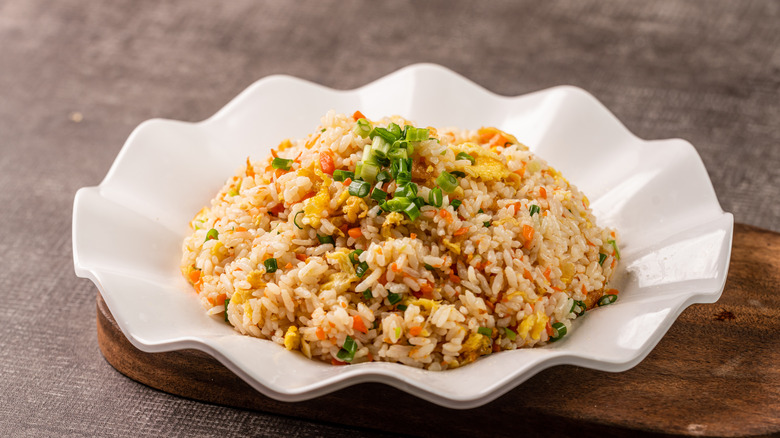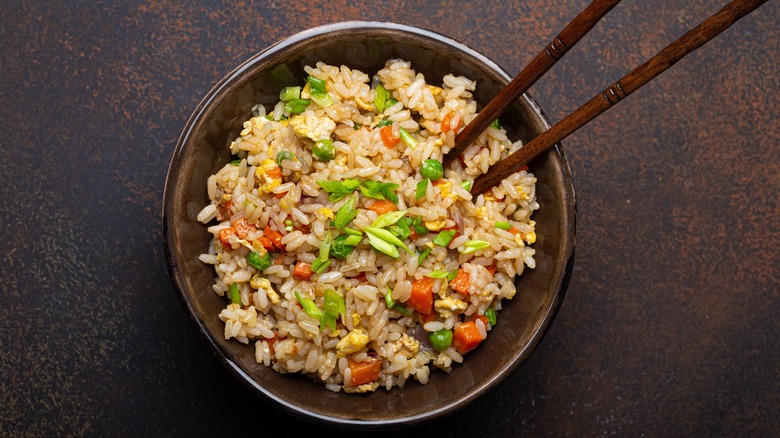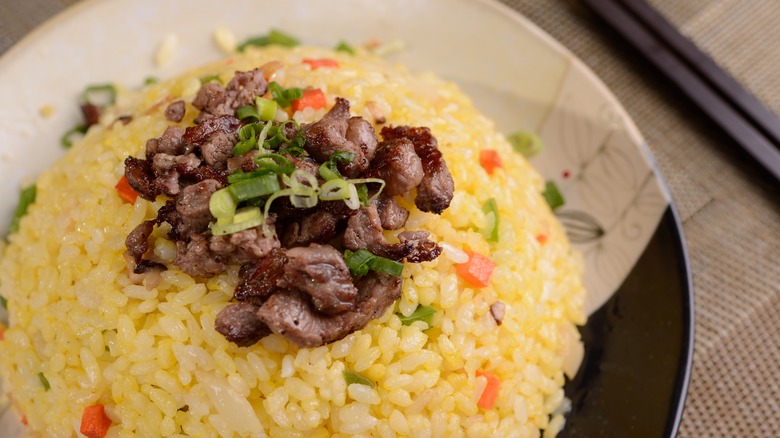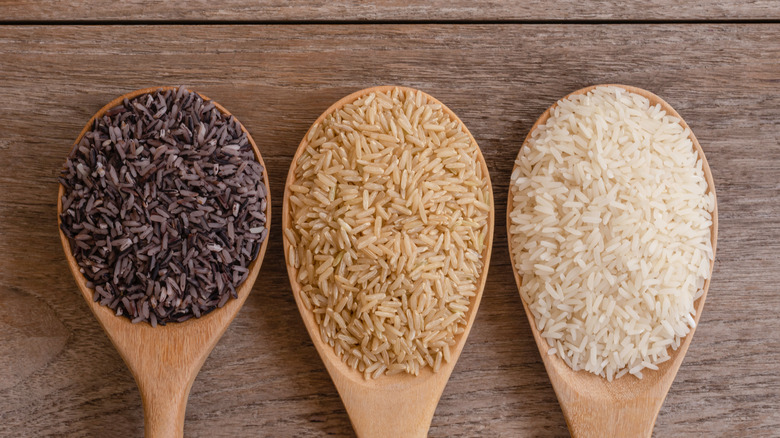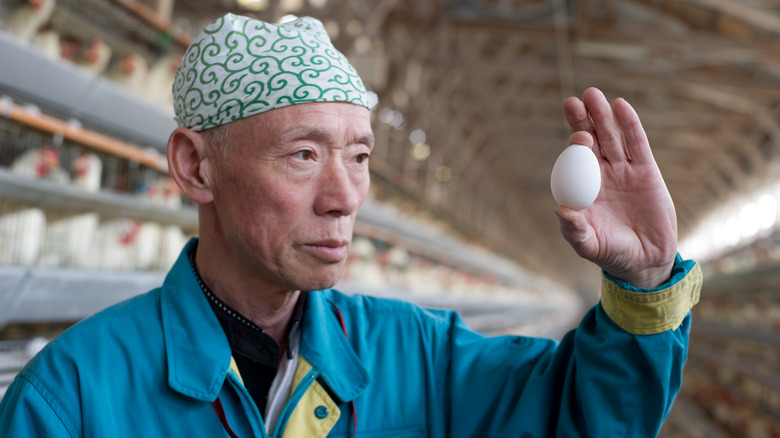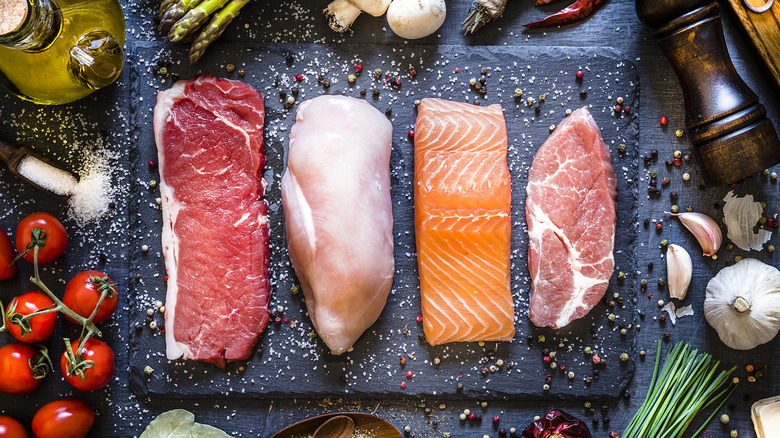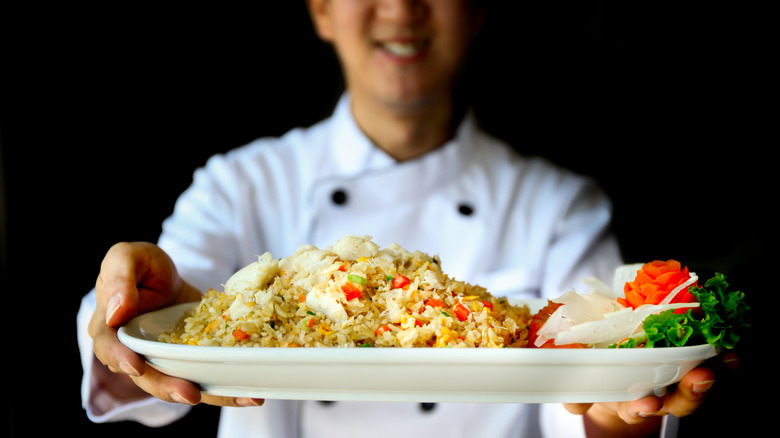Chinese Vs Japanese Fried Rice: What's The Difference?
In the wonderful world of Asian cooking, there are few dishes more iconic than fried rice. Its popularity can be attributed to how easy it is to make, how versatile the ingredient list can be, and, of course, how delicious it is. In our globalized world, you can find fried rice variations from Korea, Indonesia, Thailand, India, and more, but China is credited with inventing the very first fried rice recipe. It should be noted that the fried rice dishes you eat in any given country are likely to reflect that country's preferences. So, if you order Japanese fried rice at a restaurant in the United States, you are likely eating something that should properly be called American fried rice. The same goes for, say, France or Brazil.
With so many styles of such a simple dish, it's not always clear which kind you're eating unless you know the history. Let's take two of the most famous fried rice recipes — the Chinese and Japanese versions — and show just how different they are despite the obvious similarities. As with most foods, the differences ultimately come down to ingredients and preparation. If you zoom out, it's obvious that the dishes are two leaves on the same branch, but small differences can have a big impact on how your dinner tastes.
What is Chinese fried rice?
Fried rice most likely originated in the Jiangsu province of China in the city of Yangzhou. Its exact origins are unknown, which means the name of the chef who invented the recipe has been lost to time. What we do know is that during the Sui dynasty, which lasted from 581 to 618 AD, Emperor Yang fell in love with the dish, and it quickly disseminated to the rest of the newly united country. For several centuries, fried rice remained a Chinese dish. As anyone who knows a little Chinese history can tell you, it was a relatively isolated country until the 1800s. As China began to interact more with other countries, fried rice traveled along with other aspects of Chinese cuisine.
The method of cooking Chinese fried rice has remained constant even as the ingredients have changed over time and travel. Even within China, there are variations. Frankly, the recipe may differ from house to house given the nature of the meal, but there are also regional differences. There is the traditional recipe from Yangzhou known as Yangzhou fried rice, a milder version known as Cantonese fried rice, and Sichuan fried rice is the spicy style that emerged from the Sichuan province. Fried rice is anything but uniform.
What is Japanese fried rice?
Japanese fried rice came into being in the 19th century when Chinese immigrants moved to Japan. The Chinese immigrants used local ingredients in their fried rice, and the Japanese grew to incorporate the dish into their own cuisine under the name "yakimeshi," which translates as "pan-fried rice." In all honesty, the two styles are very similar. An untrained eye may even have difficulty telling them apart since they share so many characteristics. But, if you ever ate them side by side, you would be able to tell the difference in terms of the texture and flavor.
There's another version of Japanese fried rice called omurice, which combines the words omelet and rice together. Omurice is a part of the yoshoku style of food, which takes Western staples and adapts them to local tastes and ingredients. Since it's a marriage of Chinese, Japanese, and American cuisines, it perfectly demonstrates just how easily fried rice can be adapted into new, delicious forms.
The type of rice is different
When it comes to a dish like fried rice, the type of rice you use has a big impact on the end result. There are over 40,000 different types of rice, each of which is going to produce a totally different dish. Chinese fried rice uses varieties of long-grain white rice, which includes the likes of basmati and jasmine. This gives the dish a characteristically dry, firm texture and leads to a little more crispness when fried.
Japanese fried rice, on the other hand, uses short-grain white rice, like sushi rice aka Japanese rice. Sushi rice has a chewy texture that gets a little gummy in the mouth. Its stickiness is what makes it so good for sushi, where the rice needs to hold together. Japanese fried rice trades the crispness of Chinese fried rice for a thicker mouthfeel where all of the ingredients move together as one. The fact that short-grain rice is more common than long-grain rice in Japan explains the adaptation more than anything else.
All about eggs
Both Chinese and Japanese fried rice include eggs, but they are incorporated in different ways. Chinese fried rice is known for keeping each ingredient separate while cooking and then combining them at the end, and that includes the egg. It's usually scrambled, though sometimes it's fried and cut into strips, and then placed to the side. Some recipes instruct you to cook the egg and then add the rice to the pan. In either case, the goal is to have the egg be a distinct ingredient that you could pull out from the mix.
Japanese fried rice puts the rice into the wok or saucepan and then adds the beaten eggs on top. By doing this, the rice is covered in the egg, and they're cooked together. You'll be able to tell the difference because the rice will have a golden hue to it, and there won't be any distinct pieces of egg that you could pull out. This method makes the already chewy short-grain rice even creamier.
Traditional proteins
Chinese fried rice (and Yangzhou fried rice in particular) is known for incorporating multiple types of protein. At its most traditional, when it was being served to the emperor, there wouldn't be leftover pieces of the previous day's meal included. Instead, premium meats like roasted pork, shrimp, and scallions would be used. The inclusion of both seafood and red meat is a traditional Chinese approach.
The emphasis on meat from both sea and land carried over to Japan, certainly, but the Japanese placed particular emphasis on the seafood side of fried rice. You might see Japanese fried rice cooked with roe (the colorful, unfertilized fish eggs that pop in your mouth), cooked salmon, fish sausage, or octopus, as well as sliced ham. Two popular types of roe in Japan are ikura (salmon roe), which are big and juicy, and tobiko (flying fish roe), which are small and crunchy.
Sauces and seasonings
If you're going fully traditional, Chinese fried rice would be seasoned with salt, and that's it. Yangzhou was a salt town, and the abundance of the stuff made its way into their cuisine. As time moved on and the dish moved out and away from Yangzhou, soy sauce started to be used instead. As far as seasoning goes, sesame oil is usually included, which gives the rice a distinct nuttiness. The Cantonese style uses oyster sauce and soy sauce, while the Szechuan style uses the Sichuan pepper (think more peppercorn than chili pepper).
In Japan, you'll find that soy sauce is the common approach for the basic layer of seasoning along with the sesame oil. Oyster sauce is a common addition to bring out the umami, while in Osaka, they use Worcestershire sauce. There's also katsuobushi (crunchy flakes of dried tuna), which is sometimes thrown in for texture, and nori (dried seaweed), which Japanese cooks will cut into strips and add to the fried rice to really pull out the flavor of the sea.
